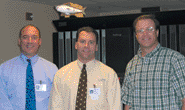Case Study: Lowery Has The Rx For Hospital's Data
It's a pity someone didn't tell St. Anthony's Medical Center a year or so earlier.
The St. Louis-based hospital, which became part of a conglomerate in the 1990s, decided to regain its independence in 2001 and "needed a ton of hardware in a hurry," said Greg Pinz, director of information systems at St. Anthony's.
Pinz called Lowery Systems, a Fenton, Mo.-based IBM solution provider that he'd heard about from a business contact.

\
St. Anthony's Rick Faszold and Greg Pinz with Lowery's Jack Russell (l. to r.) stand guard over two sharks. One's an IBM array that's helping to manage the hospital's storage needs.
Lowery brought hospital IT personnel to its Total-Storage Solution Center (TSSC) to demonstrate IBM's products. "They came in to see what the Tivoli Storage Manager software looked like and to see the tape library and servers," said Jack Russell, sales manager at Lowery. "We have different hardware and software platforms in there all the time. We let customers play."
From that visit, St, Anthony's decided to buy an IBM Shark Enterprise Storage Server array and 25 servers from Lowery, Russell said.
But time marched on, and so did the need for advanced technology. So in 2002, St. Anthony's decided to implement a PACS for digital X-rays, which would give authorized personnel access to X-ray information in a matter of seconds, Pinz said. At the same time, the government was pushing hospitals to implement systems that were HIPAA-
compliant, he said.
And that wasn't all. St. Anthony's also wanted to increase the survivability of its data in case of a disaster. "We were looking at ways to afford a duplicate Shark in case of a flood or some other problem," Pinz said.
By late 2002, the hospital decided to contract with GE Medical for its X-ray PACS, said Rick Faszold, manager of technical services at St. Anthony's. It took about six months to finalize the details of the contract, and in that time the hospital purchased and installed a second PACS from Camtronics Medical Systems for its Cardiac-Catheterization Lab.
Earlier this year, a second trip to Lowery's TSSC, along with what Russell described as "a very favorable trade-in allowance," led St. Anthony's to trade its one Shark array for two new ones, each with a capacity of 10 Tbytes.


One array was installed in the hospital's main data center and designated for general use, Faszold said.
St. Anthony's placed the second array in an adjacent building that houses much of the hospital's most important equipment and tied it to each PACS.
The two Sharks are connected to each other and mirrored, so if one goes down, the other can take over, Russell said.
In a perfect world, the two arrays would be farther away from each other, at separate facilities, Pinz said. "It was a question of cost. The second Shark is surrounded by concrete with the other equipment," he said. "We felt that if we lost both Sharks, that would mean the whole hospital was leveled, in which case lost data would be the least of our worries."
While the Sharks have been installed and connected to the Cardiac- Catheterization Lab PACS, it will be another two months or so before the X-ray PACS is installed, Russell said. At that time, Lowery will conduct tests to make sure the two systems work properly with the storage solution.
So far, the solution deployment has gone smoothly, in part because of the staff at St. Anthony's. "They're easy to work with and very knowledgeable," Russell said.
In the meantime, there's a good possibility that Lowery and St. Anthony's will continue to work together. Potential projects include an electronic document management system and a safety solution that ensures medicines are dispensed properly to hospital patients.